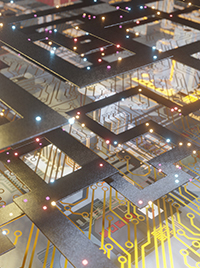How to Prepare your Network Today for
the coming Quantum Effects
By: Rana Kanaan

The emergence of quantum computing represents a technological milestone with profound implications for networking and cybersecurity. While its computational power promises breakthroughs across industries, quantum computing also threatens to disrupt the foundations of modern network security. Traditional encryption algorithms, long trusted to secure critical communications, could become obsolete in the face of quantum-powered decryption capabilities.
For Chief Information Security Officers (CISOs) and network architects, this is a call to action. It is no longer enough to simply reinforce existing defenses. The era of quantum computing demands a proactive, layered approach to cybersecurity that can preemptively address evolving threats while ensuring scalability and resilience.
Why Quantum Computing Poses a Unique Threat
Modern network security relies heavily on cryptographic algorithms to protect data in transit and at rest. Virtual Private Networks (VPNs), often built on IPsec protocols, depend on encryption standards like RSA and Diffie-Hellman for secure key exchanges. These cryptographic methods are designed to withstand attacks from classical computing but are fundamentally vulnerable to quantum capabilities.
Quantum computing excels at solving specific mathematical problems that underpin encryption. Shor’s algorithm, for instance, can efficiently factor large integers, rendering RSA, a widely used cryptographic standard, defenseless. Similarly, key exchange mechanisms like Diffie-Hellman, crucial for securing VPNs and other encrypted communications, can be compromised by quantum attacks. Even symmetric encryption protocols like AES face risks, as Grover’s algorithm can reduce their effective security by halving their key length.
The implications are vast. A successful quantum attack could decrypt sensitive data, expose critical network configurations, and compromise entire infrastructures. Worse, attackers could store encrypted communications today and decrypt them once quantum capabilities mature—a concept known as “steal now, decrypt later.”
As we have seen throughout 2024, these attacks directly on network infrastructure are on the rise and quantum computing poses a compound threat by both attacking the cryptography and the network itself. Internet-facing management interfaces of network devices, including firewalls, were increasingly targeted by attackers seeking to gain administrative control and exploit vulnerabilities. Eight telecom providers were hacked, showing that the network itself, not just it’s protections, is a ripe target. This reality presents a stark challenge for traditional networking, particularly for static and legacy systems designed for a pre-quantum era.
The Limits of Strengthening Cryptography
A common response to the quantum threat is to explore quantum-resistant cryptography, also referred to as post-quantum cryptography (PQC). Algorithms like those under review by the National Institute of Standards and Technology (NIST) offer promising solutions to safeguard against quantum decryption. However, while PQC is a critical advancement, relying solely on it is insufficient.
The challenge lies not just in encryption but in the overall architecture of network systems. Traditional networks are inherently static and predictable, characteristics that attackers exploit through reconnaissance and lateral movement. Even with quantum-resistant encryption in place, vulnerabilities in network topology, endpoint security, and operational practices remain exploitable.
This is why a more holistic approach to cybersecurity is essential, one that prioritizes adaptability, deception, and resilience alongside cryptographic strength.
Toward a Preemptive Cybersecurity Framework
To counteract the looming quantum threat, organizations must adopt preemptive cybersecurity strategies that go beyond passive defenses. Two core concepts — Automated Moving Target Defense (AMTD) and layered security — stand out as transformative approaches for securing quantum-ready networks.



















